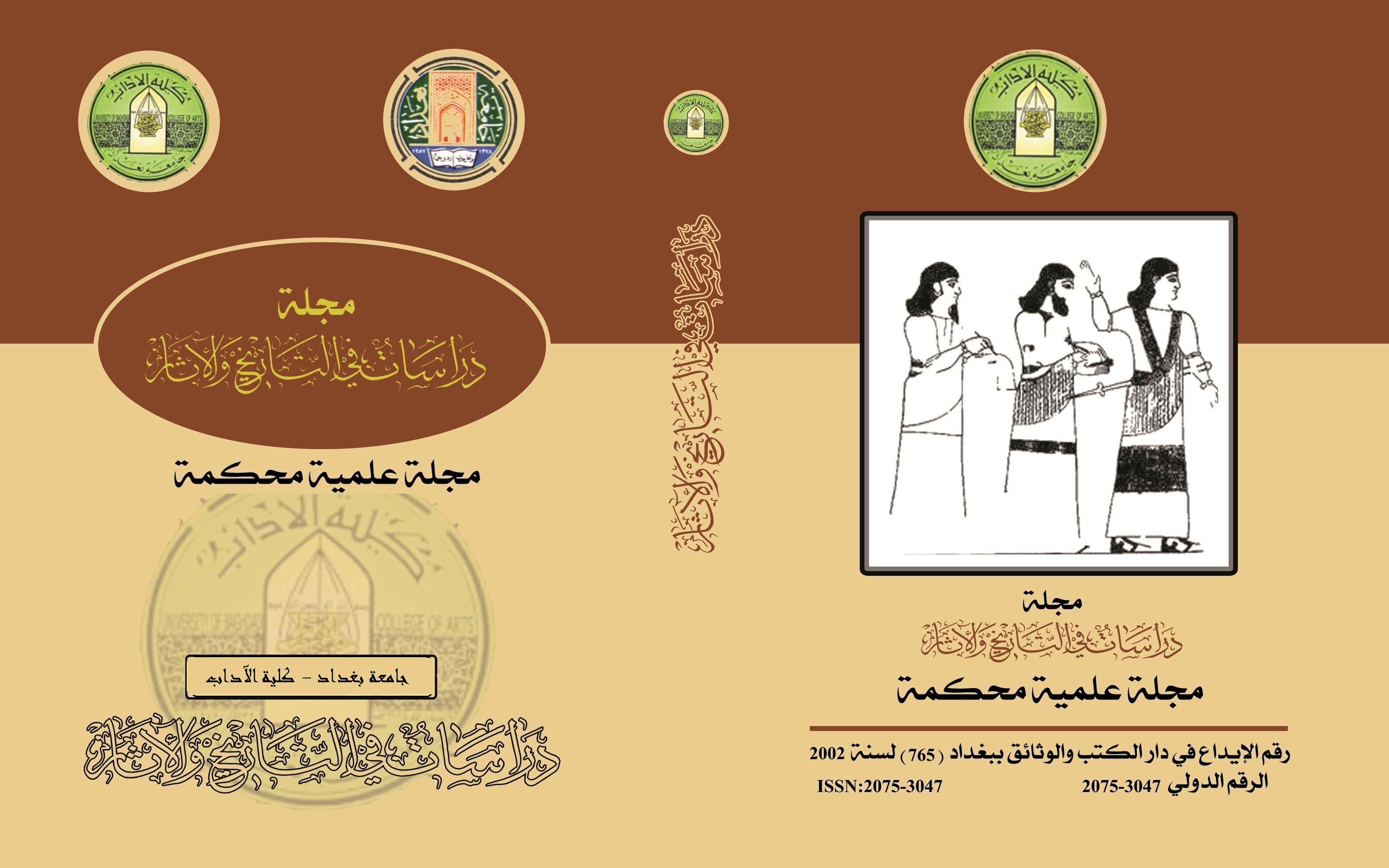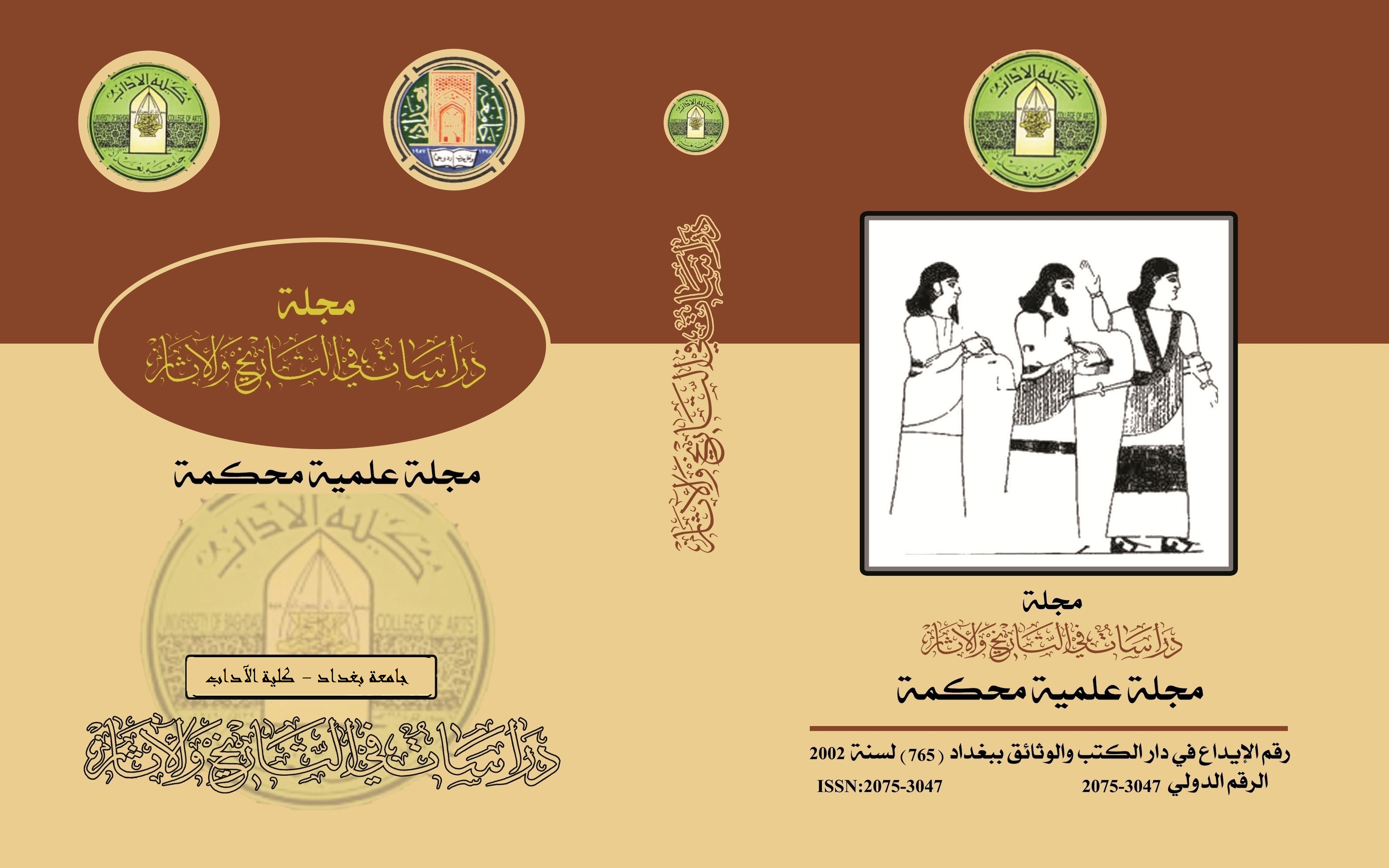دور المدرسة العثمانية في تطوير الفنون الثقافية العربية (خط الطغراء انموذجا)
الكلمات المفتاحية:
المدرسة العثمانية، الفنون الثقافية، خط الطغراءالملخص
جاء هذا البحث لتسليط الضوء على موضوع غاية في الأهمية وهو دور المدرسة العثمانية في تطوير الفنون الثقافية العربية (خط الطغراء انموذجا)، وذلك من خلال تناول الخط العربي في المدرسة العثمانية، وماهية خط الطغراء، والطغراء على النقود العثمانية ومراحل تطورها. وقد خلص البحث لعدد من النتائج من أهمها أن المدرسة العثمانية استطاعت أن تتمثل بعناصر جديدة توجد الملامح والخصائص المميزة للتعبير، فقد نجحت في إبداع أساليب ومواضيع أخذ العصر بالتطبع بطباعتها. فبفضل المعايير الموضوعة لهندسة الحروف والنسب الفاضلة، التي حققت الدقة والتوازن في قياس كل حرف، بالإضافة للتناسب بين الخط والنقطة والدائرة. كما اكتسب الخط العربي السمة الجمالية وزاد اتقاناً وجمالاً في درجات ابداعه الفني وأصبح فناً له ما يقارب الثمانين أسلوباً وطريقة. كما أن العثمانيين نظروا للحرف نظرة إجلال وإكبار. تعد الطغراء صورة فريدة للتوقيع المترف والرسمي البالغ الجمال لسلاطين الدولة العثمانية، كما أنها تعد أرقى ما توصل إليه الفن المدرسة العثمانية في تطوير فنون الخط العربي الذي يعد من الفنون الثقافية العربية، وهي إحدى الصور الزخرفية للخط العربي، والتي سعى الخطاط العثماني في التفنن بها.
المراجع
ابراهيم احمد عبد الفتاح، القاموس القويم للقرآن الكريم، الهيئة العامة لشؤون المطابع الأميرية بالقاهرة، 1983، ج1.
احمد السعيد سليمان، تأصيل ما ورد في تاريخ الجبرتي من الدخيلن دار المعارف ،1979.
احمد سليمان، تأصيل ما ورد في تاريخ الجبرتي من الدخيل، دار المعارف، 1979.
ادهام محمد حنش، كتابة المصحف الشريف عند الخطاطين العثمانيين: دراسة تاريخية- فنية، مجلة البحوث والدراسات القرآنية، العدد السابع، السنة الرابعة، جامعة العلوم الإسلامية العالمية، 2013.
ادهام محمد، الخط العربي في الوثائق العثمانية، عمان، 1998.
أدهم محمد حنش، المدرسة العثمانية لفن الخط العربي، مكتبة إلامام البخاري، القاهرة، 2016.
اسماعيل حقي، يازي أوكره تمه نك يولي، مجلة "تدريسات ابتدائية مجموعة سي" إستانبول "رئيس التحرير ساطع الحصري، السنة الأولى 1326 رومي 1328هـ 1910م (العدد) 5.
أقطاي أصلان آبا، قانون الترك وعمائرهم، ترجمة: أحمد عيشى، إستانبول، 1987.
أكمل الدين إحسان اوغلى، الدولة العثمانية تاريخ وحضارة، مركز الأبحاث للتاريخ والفنون والثقافة الإسلامية، ترجمة: صالح سعداوي، إستانبول، 1999.
أكمل الدين احسان أوغلى، الدوللة العثمانيلة تاريخ وحضارة، ترجمه للعربية: صالح أسعد، استنبول، 1999.
الجبرتي، (عبد الرحمن بن حسن ت: 1237هـ) عجائب الآثار في التراجم والأخبار، اجزاء، تحقيق: عبد الرحيم عبد الرحمن عبد الرحيم، مطبعة دار الكتب المصرية، القاهرة، 1998.
جمال الدين ابو الفضل محمد بن مكرم بن علي ابن منظور، ت: 711هـ/1311م، لسان العرب، تحقيق: علي عبد الله الكبير، مج2، دار المعارف، القاهرة، دون تاريخ.
حسن عبد الرحيم عليوة، الكتابات الأثرية العربية دراسة في الشكل والمضمون، ط2، القاهرة، 1998.
حمود محمد الشافعى دور المدرسة العثمانية فى إثراء الخط العربي والمحافظة علي، ملتقى القاهرة الدولي، https://www.cdf.gov.eg/khate/?q=ar/node/1933
خير الدين الزركبي، الاعلام قاموس تراجم لأشهر الرجال والنساء من العرب والمستعربين والمستشرقين، دار العلم للملايين، بيروت، 2002، ج2.
رأفت النبراوي، الخط العربي على النقود الإسلامية، مجلة كلية الآثار، جاعة القاهرة، العدد الثامن، مبطعة جامعة القاهرة، 2000.
روحي البعلبكي، قاموس المورد، قاموس عربي-انجليزي، ط7، دار العلم للملايين، بيروت، 1995.
زامباور، معجم الأنساب والأسرات الحاكمة فى التاريخ الإسلامى، ترجمة زكي حسن، دار الرائد العربي، بيروت، 1980.
الصفصافي أحمد المرسي، الوثائق العثمانية (الدبلوماتيك)، القاهرة، 2004.
عباس العزاني، الخط العربي في تركيا، مجلة سومر، مج32، الجزء الأول والثاني، مديرية الآثار العامة، بغداد، 1876.
عبد الرحيم بن عبد الرحمن بن احمد بن حسن بن داود بن سالم أبو الفتح بدر الدين العباس، ت: 963هـ/1556م، منح رب البرية في فتح رودس الأبية، حوليات كلية الآداب، جامعة الكويت، 1998.
عبد العزيز مرزوق، الفنون الزخرفية في العصر العثمان، القاهرة، 1973.
عبد الفتاح عبادة، انتشار الخط العربي في العالم الشرقي والعالم الغربي، ط2، مكتبة الكليات الأزهرية، القاهرة،2017.
عبد الفتاح مصطفى غنيمي، صناعة الكتاب المخطوط عند المسملين، دار الفنون العلمية، الإسكندرية، ج1، 1994.
عبده ابراهيم محمد اباظة، الطغراء على النقود العثمانية، المؤتمر الخامس عشر للاتحاد العام للآثاريين العرب المنعقد في جامعة الملك محمد الأول، في جدة، في الفترة من 13-15 اكتوبر/ 2012، ج2، 2012.
عبده ابراهيم محمد أباظة، النقود المتداولة في مصر في عصر محمد علي باشا (1220-1264هـ/1805-1848م) رسالة ماجستير، كلية الآثار، جامعة القاهرة، القاهرة، 1999.
عزمي سلام، مدخل إلى الميتافيزيقيا، مكتبة سعيد رأفت، القاهرة، 1977.
علا الدين بدوني الخضري، المدفع في العصر الثعماني في ضوء مجموعات المتحف وتصاوير المخطوطات العثمانية منذ الفتح العثماني وحتى نهاية القرن التاس عشر الميلادي، رسالة ماجستير، جامعة جنوب الوادي، لسودان، 2007.
علاء الدين بدوي، المدفع في العصر العثماني في ضوء مجموعات المتحف وتصاوير المخطوطات العثمانية منذ الفتح العثماني وحتى نهاية القرن التاسع عشر ا لميلادي، رسالة ماجستير، جامعة جنوب الوادي، السودان، 2007.
قتيبة الشهابى، معجم ألقاب أرباب السلطان فى الدول الإسلامية من العصر الراشدي حتلى . بدايات القرن العشرين، دمشق، 1995.
كامل البابا، روح الخط، دار العلم للملايين، بيروت، ط3، 1994.
محمد أحمد دهمان، معجم الألفاظ التاريخية في العصر المملوكي، دار الفكر المعاصر، بيروت، 1990.
محمد باقر الحسيني، الخط أسلوبه وأنواعه وميزاته على النقود الإسلامية في العهد السلجوقي، مجلة سومر، مج24، الجزء الأول والثاني، مديرية الآثار العامة، بغداد 1968.
محمد علي حامد بيومي، الطغراء العثمانية، رسالة ماجستير، جامعة القاهرة، قسم الآثار الإسلامية، 1985.
محمد علي حامد بيومي، الطغراء العثمانية، رسالة ماجستير في الآثار الإسلامية، جامعة القاهرة، القاهرة، 1985.
محمد فريد أبو حديد، تاريخ الدولة العلية العثمانية، تحقيق إحسان حقي دار النفائس، بيروت، 1981، ص153..
معمر أولكر، فن الخط التركي بين الماضي والحاضر، شركة دوغوش للتجارة والطباعة المحدودة، أنقرة، 1987.
هشام إبراهيم عز الدين محمد، أثر أُسلوب الخطاط ياقوت المستعصمي على أعمال خطاطي الدولة العثمانية، مجلة العلوم الاسلامية والاقتصادية، العدد 1، المجلد 14.
وليد سيد حسنين، فن الخط العربي المدرسة العثمانية، الهيئة المصرية العامة للكتاب، القاهرة، 2015.
يحيى وهيب الجبوري، الخط والكتابة في الحضارة العربية، دار الغرب الإسلامي، بيروت، 1994.
يوسف ذنون، تيسير تعلم الخط العربي في الأقطار العربية منذ اواخر العهد العثماني وحتى الوقت الحاضر، بحث في ندوة الفنون الِإسلامية، المبادئ والأشكال والمضامين المشتركة، مركز الأبحاث للتاريخ والفنون والثقافة الإسلامية، دار الفكر، دمشق، 1998.
المراجع الأجنبية
Album: Auction No. 9: Rare Coins, Ancient Dynasties, China, India, Europe, Americas / Australia Coins, Islamic & Pacific, California 2012, No.147.
Album: Auction No. 9: Rare Coins, Santa Rosa, USA , December 11th, 2010, No.147.
Album Stephen: Auction 9: Rare Coins, Santa Rosa, USA, December 11th, 2010, No.93.
Gerard Clauson: An Etymological Dictionary of pre-Thirteenth- century Turkish, Oxford, The Clarendon Press, 1972.
Ibrahim Artuk, Istanbul Arkeoloji Muzelere Teshirdeki Islami Sikkeler Katalogu , Cilt Istanbul 1970 , No. 1387.
Michael Mitchiner, The World of Islam. Oriental Coins and Their Values, London 1977, P.205, No.1241.
References List:
Arabic References:
Ibrahim Ahmed Abdul Fattah, The Comprehensive Dictionary of the Holy Quran, General Authority for Amiri Printing in Cairo, 1983, Vol. 1.
Ahmed Al-Saeed Sulaiman, The Foundations of What is Mentioned in the History of Jabarti by Al-Dakhil, Dar Al-Ma'arif, 1979.
Ahmed Sulaiman, The Foundations of What is Mentioned in the History of Jabarti by Al-Dakhil, Dar Al-Ma'arif, 1979.
Adham Mohammed Hanash, Writing the Noble Quran Among the Ottoman Calligraphers: A Historical-Artistic Study, Journal of Quranic Research and Studies, Issue Seven, Fourth Year, International Islamic Sciences University, 2013.
Adham Mohammed, Arabic Calligraphy in Ottoman Documents, Amman, 1998.
Adham Mohammed Hanash, The Ottoman School of Arabic Calligraphy, Imam Al-Bukhari Library, Cairo, 2016.
Ismail Haqqi, Yazı Okreh Tama Nak Yoli, Journal "Elementary Teaching Group C" Istanbul "Editor-in-Chief Satı Al-Hussari, First Year 1326 Rome 1328 AH 1910 AD (Issue) 5.
Aktai Aslan Aba, Turkish Law and Their Monuments, Translation: Ahmed Aishi, Istanbul, 1987.
Akmel al-Din Ehsan Oghlu, The Ottoman State: History and Civilization, Research Center for Islamic History, Arts, and Culture, Translation: Saleh Saadawi, Istanbul, 1999.
Akmel al-Din Ehsan Oghlu, The Ottoman State: History and Civilization, Translated into Arabic by Saleh Asaad, Istanbul, 1999.
Al-Jabarti, (Abd al-Rahman ibn Hasan d. 1237 AH) Wonders of Monuments in Biographies and News, Parts, Edited by Abdul Rahim Abdul Rahman Abdul Rahim, Dar Al-Kutub Al-Masriyah Printing Press, Cairo, 1998.
Jamal al-Din Abu al-Fadl Muhammad ibn Makram ibn Ali ibn Manzur, d. 711 AH/1311 AD, Lisan al-Arab, Edited by Ali Abdullah Al-Kabeer, Vol. 2, Dar Al-Ma'arif, Cairo, Undated.
Hassan Abdul Rahim Aliwa, Arabic Archaeological Writings: A Study in Form and Content, Second Edition, Cairo, 1998.
Hamoud Mohammed Al-Shafai, The Role of the Ottoman School in Enriching Arabic Calligraphy and Preserving it, Cairo International Forum, [Online] Available: https://www.cdf.gov.eg/khate/?q=ar/node/1933
Khair al-Din al-Zarkali, Al-I'lam: A Dictionary of Biographies of the Most Famous Men and Women from Arabs, Arabized, and Orientalists, Dar Al-Ilm Lil Malayin, Beirut, 2002, Vol. 2.
Rafat al-Nabrawi, Arabic Calligraphy on Islamic Coins, Journal of the Faculty of Archaeology, Cairo University, Eighth Issue, Cairo University Press, 2000.
Ruhi al-Baalbaki, Al-Mawrid Dictionary, Arabic-English Dictionary, 7th Edition, Dar Al-Ilm Lil Malayin, Beirut, 1995.
Zambour, Dictionary of Lineages and Ruling Families in Islamic History, Translation: Zaki Hassan, Dar Al-Raed Al-Arabi, Beirut, 1980.
Safsafi Ahmed al-Mursi, Ottoman Diplomatic Documents, Cairo, 2004.
Abbas Al-Azzani, Arabic Calligraphy in Turkey, Sumer Magazine, Issue 32, Parts One and Two, General Directorate of Antiquities, Baghdad, 1876.
Abdul Rahim ibn Abdul Rahman ibn Ahmad ibn Hasan ibn Dawood ibn Salem Abu al-Fateh Badr al-Din al-Abbas, d. 963 AH/1556 AD, Blessings from the Lord of Hosts in Conquering Rhodes, Annals of the Faculty of Arts, Kuwait University, 1998.
Abdul Aziz Marzouk, Decorative Arts in the Ottoman Era, Cairo, 1973.
Abdel Fattah Abada, Spread of Arabic Calligraphy in the Eastern and Western Worlds, 2nd Edition, Al-Azhar Colleges Library, Cairo, 2017.
Abdel Fattah Mustafa Ghoneimi, Manuscript Writing among Muslims, Dar Al-Fun Al-Ilmiyah, Alexandria, Vol. 1, 1994.
Abdou Ibrahim Mohamed Abaza, The Ottoman Coinage, Fifteenth Conference of the General Union of Arab Archaeologists held at King Mohammed I University, Jeddah, October 13-15, 2012, Vol. 2, 2012.
Abdou Ibrahim Mohamed Abaza, Coins Circulated in Egypt during the Era of Muhammad Ali Pasha (1220-1264 AH/1805-1848 AD), Master's Thesis, Faculty of Archaeology, Cairo University, Cairo, 1999.
Azmi Salam, Introduction to Metaphysics, Saeed Raffat Library, Cairo, 1977.
Ala al-Din Boudoni Al-Khudari, Artillery in the Ottoman Era in Light of Museum Collections and Images of Ottoman Manuscripts from the Ottoman Conquest to the End of the Nineteenth Century, Master's Thesis, University of South Valley, Sudan, 2007.
Hisham Ibrahim Aziz al-Din Muhammad, The Influence of Calligrapher Yaqut al-Mustasimi's Style on the Works of Ottoman Calligraphers, Journal of Islamic and Economic Sciences, Issue 1, Volume 14.
Walid Sayed Hassanein, The Art of Arabic Calligraphy: The Ottoman School, Egyptian General Authority for Books, Cairo, 2015.
Yahya Waheeb Al-Jubouri, Calligraphy in Arab Civilization, Dar Al-Gharb Al-Islami, Beirut, 1994.
Youssef Zanon, Facilitating the Learning of Arabic Calligraphy in Arab Countries from the Late Ottoman Period to the Present, Paper Presented at the Islamic Arts Conference, Principles, Forms, and Common Themes, Research Center for Islamic History, Arts, and Culture, Dar Al-Fikr, Damascus, 1998.
التنزيلات
منشور
إصدار
القسم
الرخصة

هذا العمل مرخص بموجب Creative Commons Attribution 4.0 International License.
:حقوق الطبع والنشر والترخيص
بالنسبة لجميع البحوث المنشورة في مجلة دراسات في التاريخ والآثار، يحتفظ الباحثون بحقوق النشر. يتم ترخيص البحوث بموجب ترخيص Creative Commons CC BY 4.0 المفتوح ، مما يعني أنه يجوز لأي شخص تنزيل البحث وقراءته مجانًا. بالإضافة إلى ذلك ، يجوز إعادة استخدام البحث واقتباسه شريطة أن يتم الاستشهاد المصدر المنشور الأصلي. تتيح هذه الشروط الاستخدام الأقصى لعمل الباحث وعرضه.
:إعادة إنتاج البحوث المنشورة من الناشرين الآخرين
من الضروري للغاية أن يحصل الباحثون على إذن لإعادة إنتاج أي بحث منشورة (أشكال أو مخططات أو جداول أو أي مقتطفات من نص) لا يدخل في نطاق الملكية العامة أو لا يملكون حقوق نشرها. يجب أن يطلب الباحثون إذنًا من مؤلف حقوق النشر (عادة ما يكون الناشر).
يطلب الإذن في الحالات التالية:
بحوثك الخاصة المنشورة من قِبل ناشرين آخرين ولم تحتفظ بحقوق النشر الخاصة بها.
مقتطفات كبيرة من بحوث أي شخص أو سلسلة من البحوث المنشورة.
استخدم الجداول والرسوم البيانية والمخططات والمخططات والأعمال الفنية إذا لم يتم التعديل عليها.
الصور الفوتوغرافية التي لا تملك حقوق لنشرها.
لا يطلب الإذن في الحالات التالية:
إعادة بناء الجدول الخاص بك مع البيانات المنشورة بالفعل في مكان آخر. يرجى ملاحظة أنه في هذه الحالة يجب عليك ذكر مصدر البيانات في شكل "بيانات من ..." أو "مقتبس من ...".
تعتبر عروض الأسعار القصيرة معقولة الاستخدام العادل ، وبالتالي لا تتطلب إذنًا.
الرسوم البيانية ، الرسوم البيانية ، المخططات ، الأعمال الفنية التي أعاد الباحث رسمها بالكامل والتي تم تغييرها بشكل ملحوظ إلى درجة لا تتطلب الاعتراف.
الحصول على إذن
لتجنب التأخير غير الضروري في عملية النشر ، يجب أن تبدأ في الحصول على أذونات في أقرب وقت ممكن. لا يمكن لمجلة الآداب نشر بحث مقتبس من منشورات أخرى دون إذن.
قد يمنحك مالك حقوق الطبع والنشر تعليمات بشأن شكل الإقرار الواجب اتباعه لتوثيق عمله ؛ بخلاف ذلك ، اتبع النمط: "مستنسخ بإذن من [المؤلف] ، [كتاب / المجلة] ؛ نشره [الناشر] ، [السنة]." في نهاية شرح الجدول ، الشكل أو المخطط.



















